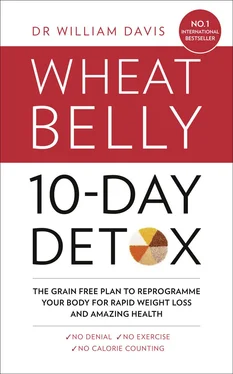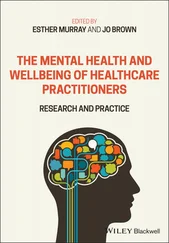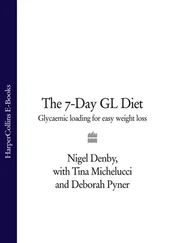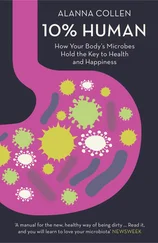It is important that, as part of your carbohydrate management effort, you do not limit fats or oils. In the Wheat Belly 10-Day Detox, there are no limits on fat or oil intake, provided you choose your sources wisely. It means you should enjoy the fat on meats, just like your grandparents did. Don’t buy meats lean; buy fatty cuts. Don’t trim the fat off beef, pork, lamb, or poultry; eat it. Eat dark poultry meat, as well as white. In addition:
Save fats from cooking beef, pork, and bacon in a container and refrigerate to use as cooking oil.
Save the bones (or buy them from a butcher) to make soup or stock and don’t skim off the fat when it cools.
Consider enjoying bone marrow.
Don’t limit egg consumption. Have a three-egg omelet, for instance, with lots of extra-virgin olive oil, pesto, or olive oil–soaked sun-dried tomatoes.
Use the oils listed above generously in every dish possible.
The Fairy Tale of Glycemic Index
The Wheat Belly 10-Day Detox is a hard-hitting natural approach for gaining incredible control over weight and health in as short a time as possible. There are no fictions or fairy tales here. But some popular nutritional fairy tales could confuse you or undo the benefits you are trying to achieve. The concept of glycemic index (GI) is one good example: a fictional notion that, if believed like a fairy tale, could have you kissing frogs to make princes.
GI assigns values to foods that describe how high blood sugar climbs over 90 minutes after consuming that food compared to glucose. The GI of a pork chop? Zero: no impact on blood sugar. Three scrambled eggs? Also zero. A plate of kalamata olives and big wedge of feta cheese? Zero again. A zero glycemic index applies to all other meats, fats, oils, most nuts, cheeses, mushrooms, and nonstarchy vegetables. Eat any of these foods and blood sugar won’t budge and insulin will not be provoked beyond a minimal level.
While there is really nothing wrong with the concept of GI or the related concept of glycemic load (GL), which factors in quantity of food, the problem lies in how values for GI and GL are interpreted. Standard practice is to (arbitrarily) break GI levels down into high GI (70 or greater), moderate GI (56 to 69), and low GI (55 or less), while GL is broken down into high GL (20 or greater), moderate GL (11 to 19), and low GL (10 or less).
Can you be a little bit pregnant? Can you have a little nuclear war? The same applies to GI: There should be no “low” or “high” distinguished by such small differences. All GI levels are associated with blood sugars that are too high if weight loss and ideal metabolic health are your goals. Applying the flawed logic of the GI, cornflakes, puffed rice, and pretzels have high GIs (above 70), while whole grain bread, oatmeal, and rice have low GIs, resulting in the conventional advice to includes lots of these low-GI foods in your diet.
A typical nondiabetic person who consumes 125 g (4½ oz) of oats—a low-GI food—in 120 ml (4 fl oz) cup of milk without added sugar will experience a blood sugar level in the neighborhood of 9 mmol/L. This is a high level that provokes the weight-loss blocking effect of insulin, not to mention also triggering (over time) adrenal disruption, cataract formation, damage to joint cartilage, hypertension, heart disease, and neurological deterioration or dementia when provoked repeatedly, as with oatmeal for breakfast every morning. A blood sugar of 10 mmol/L may not be as high as, say, the 10 mmol/L that occurs after consuming a high-GI food, such as a bowl of cornflakes or puffed rice cereal. But it is still high enough to provoke all the destructive effects of high blood sugar.
Low GI would therefore be more accurately labeled as “less-high” GI. Even better, we could just recognize that any GI above zero or low single-digit values should be regarded as high.
The concept of glycemic load that factors in portion size is no better. Under this system, the GL of cornflakes is 23, the GL of oatmeal is 13, and the GL of whole wheat bread is 10, once again lulling you into thinking that foods like oatmeal and whole wheat bread don’t raise blood sugar. But they do. Foods like oats and whole wheat bread don’t have low GLs; they have less high GLs.
Is there a value that better predicts whether there will be a blood sugar rise? Yes: grams of carbohydrates. Specifically, net grams of carbohydrates obtained by subtracting fiber (since fiber, while included in the total carbohydrates value on nutritional panels, is not digested to sugar):
NET CARBOHYDRATES = TOTAL CARBOHYDRATES – FIBER
If you were to test blood sugars with a fingerstick glucose meter 30 to 60 minutes after consuming a food (when peak blood sugar usually occurs, not 2 hours as advised by physicians for diabetic blood sugar control), you would see that it takes most of us 15 g net carbohydrates before blood sugars rise, regardless of whether they are high-, medium-, or low-GI. We have based all Wheat Belly 10-Day Detox dietary choices and recipes on this limit.
Let’s dash another fairy tale commonly offered by the dietary community that can trip up your weight-loss efforts. They often tell us that if a high-GI food is consumed with added proteins, fats, or fiber, the glycemic effect will be reduced. As often occurs in the fictional tales of nutrition, this is an example of something being less bad but not necessarily good. A typical blood sugar after consuming two slices of multigrain bread on an empty stomach might be 10 mmol/L—high enough to provoke insulin, cortisol, insulin resistance, visceral fat accumulation, and inflammation. Consume two slices of multigrain bread with some slices of turkey, mayonnaise, lettuce, and tomatoes, and blood sugar will be around 9 mmol/L—better, yes, but still pretty high.
Less bad is not necessarily good. The wolf can wear Grandma’s nightie, but he’s still a big, bad, ugly wolf.
If you are worried about your cholesterol, know that the majority of people will experience a reduction in the LDL (bad) cholesterol with this lifestyle, along with plummeting triglycerides and a rise in healthy HDL. Eating fats and oils normalizes these predictors of cardiovascular risk. (A full discussion of the why behind these changes, and why and how a low-fat diet ruins health and booby-traps cardiovascular risk, can be found in both the original Wheat Belly and in Wheat Belly Total Health.)
REBECCA, 44, sales, Connecticut
“Funny: 8 nights with no binge eating and I forgot that for the past 8 years I have binged before going to bed—my biggest demon. I once read that this lady turned her kitchen faucet on so no one would hear her going in the freezer with a spoon to get ice cream. I couldn’t believe someone else did that! Wow! This was an addiction, and following the guidelines of Dr. Davis worked. For once I didn’t have to pretend to myself that I wasn’t starving. Once I gave him my full trust in the process, I upped my fat intake and that was my saving grace.”
If we are going to increase our intake of fats and oils, it also means avoiding foods labeled “low-fat” or “nonfat.” These terms mean high carbohydrate and high sugar and also serve as buzzwords for grains. Yes, conventional notions of healthy foods with reduced fat have not just wasted our time, but disposed of any control we may have hoped for in weight and health. Have nothing to do with them. If you consume dairy products, for instance, pour the fat-free, 1%, or 2% milk down the drain and go for the full fat or cream. No light coconut milk; we want the thickest, fattiest variety.
We also avoid hydrogenated fats, or trans fats, a common ingredient in processed foods, especially grain-based foods, as they contribute to heart disease, hypertension, and diabetes. Margarine is the worst, made with vegetable oils hydrogenated to yield a solid stick or tub form. Many processed foods, from cookies to sandwich spreads, contain hydrogenated oils and should be avoided for this and other reasons. Use real organic butter or ghee instead (if you include dairy).
Читать дальше












